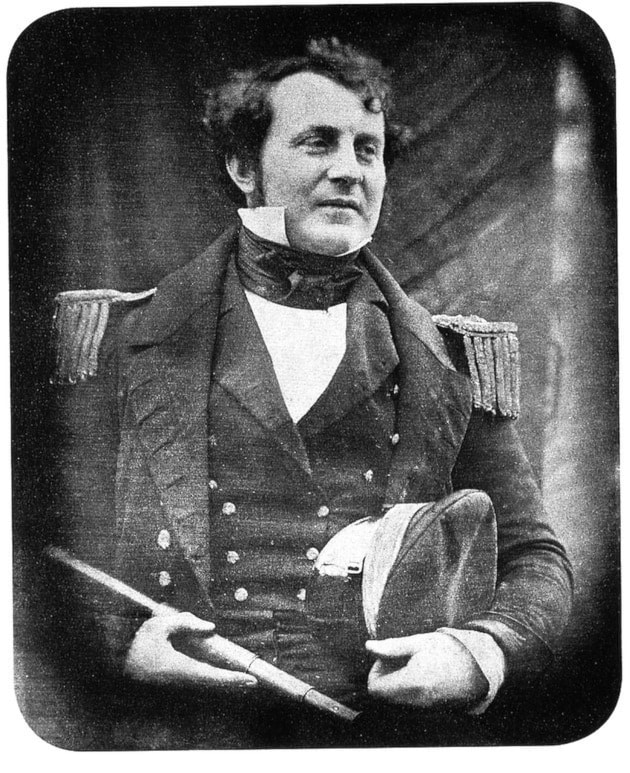Two winters ago I connected with William Battersby, British author of a biography of James Fitzjames, who perished in the Arctic, along with John Franklin and 127 other men. He was in command of HMS Erebus after Franklin’s death.
Our discussions centered on the two records that were found in cairns on King William Island, both written by Fitzjames. Although the records cleared up a lot of the mystery behind the tragedy, certain ambiguities persisted. Battersby felt Franklin could not have sufficient time to circumnavigate Cornwallis Island prior to settling in for overwintering at Beechey Island in 1845. I was of the same opinion and looked carefully at the record. It all hinges on one sentence:
“Having wintered in 1846-7 [should be 1845-6] at Beechey Island in [coordinates follow] after having ascended Wellington Channel to Lat 77 and returned by the West side of Cornwallis Island.”
I noticed that Fitzjames had a peculiar habit of writing the letter a in lower case form only, and just writing it larger to signify it was a capital. That was evident in the word April and in a short phrase (All well), where capitals would be expected. He also implies a capital in the word After in the sentence quoted above. That changes the entire meaning, from “having wintered on Beechey Island after having ascended ...” to “having wintered on Beechey Island. After [i.e., afterward] having ascended ...” In other words, that event occurred in the summer of 1846, after the ships left their winter quarters, leaving behind three sailors, who had died from the effects of lead poisoning from poorly soldered ration tins. They were the lucky ones.
After the push northward around Cornwallis Island, Franklin led his flotilla south into Peel Sound, and then south-westward into Victoria Strait. Here they encountered the unrelenting conveyor belt of ice floes from the Beaufort Sea, which surrounded their ships and locked them in an unyielding grip. Had Franklin adopted the narrower passage to the east of King William Island, he would have found the Northwest Passage he was seeking.
In May 1847 Franklin sent an expedition under Lt. Graham Gore to King William Island, with instructions to place two notes in cairns. The nearly-identical notes were written by Fitzjames on board the Erebus and sealed in metal cylinders. Nothing is said about Gore’s main task on this expedition, and historians have assumed they set out on a long trek southward to procure fresh meat.
On this point I offered an alternate explanation. The men, I believe, had been directed to head east (a much shorter journey) to see if the eastern channel was opening and if it appeared to be navigable. Gore would have witnessed a reassuring sight and rushed back to advise Franklin, depositing the second record in a new cairn several miles south of the first one at Victory Point. Back at the ship, they found Franklin on his death bed. Gore would follow before another year was out.
Eleven months later, the surviving men made a desperate move. Under the leadership of Francis Crozier, they set out on a march southward, towards the mainland, in the vain hope of reaching some outpost of civilization. Fitzjames updated the note he had written the previous year with the grim news. Some were able to get off the island, only to die in the estuary of Back River. The majority of the 105 souls perished along the island shores as they succumbed to scurvy and starvation. Cannibalism stretched out resources for the hardier ones.
There is evidence that the party split up several days after departure, and a fraction decided to return to the ships. Fitzjames was probably among them. Fortune may have smiled at him as tentative leads opened up around the Erebus, allowing him to carefully work her southward, probably using the steam engine on board. Eventually the ice trapped them again.
During the winter Inuit hunters saw an icebound ship just off the Adelaide Peninsula, with smoke coming out of a stack. There was still life on board. Later when all signs had faded, the hunters boarded the ship and discovered a corpse of a giant. Fitzjames was a tall man, and the local Inuit were short in stature.
That, of course, is precisely the spot where the Erebus was found. Battersby is quite sure Fitzjames had manoeuvred the ship to that location, with some additional positioning by drift ice prior to sinking. We are both eagerly awaiting results of the archaeological surveys by Parks Canada.
Below: The upper half of the Victory Point Record, including the sentence Walter Volovsek discusses. The 1848 update is written around the margins.

Walter Volovsek’s website can be found at trailsintime.org
Previous installments in this series
Connecting with Albert McCleary
Lilette Mahon: A mentor’s gift
Edward Mahon: Searching for a legacy
Edward Mahon: A stimulating childhood
Intrigues: Castlegar’s lacklustre childhood
Perceptions: Adrift on the River of Life
Local history interwoven with rivers
Drawn into the currents of time
